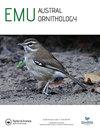Unsustainable exploitation of wild birds in Wallacea – An uncertain road for conservation emerging from the pandemic
IF 1.1
4区 生物学
Q3 ORNITHOLOGY
引用次数: 0
Abstract
Wallacea, comprising the archipelagos of Sulawesi, the Lesser Sundas, and Maluku, is an engine of bird species diversification (McCullough et al. 2022), supporting high levels of endemism, and clearly an important region for bird conservation globally (Monk et al. 1997; Burung Indonesia 2014). Wallacea’s charismatic flagships include the Maleo Macrocephalon maleo, Standardwing Semioptera wallacii, and an array of Australasian taxa such as parrots, pigeons, and honeyeaters – the region holds more than 130 Important Bird and Biodiversity Areas or IBAs (Trainor et al. 2007; BirdLife International 2022). Disconcertingly, Wallacea’s birdlife is imperilled by a myriad of pressures, including high rates of habitat loss and unsustainable exploitation of its biodiversity (Lambert 1993; Trainor et al. 2007; Burung Indonesia 2014), whilst frequently slipping through the radar of conservationists. These threats were amplified during the COVID-19 pandemic while efforts to protect Wallacea’s avian biodiversity has correspondingly weakened. Arguably the most insidious threat to Wallacea’s birdlife is the unsustainable harvest of wild birds for the pet trade, of which parrots form the majority (Lambert 1993; Monk et al. 1997; Burung Indonesia 2014; Pires et al. 2021). Wallacean parrots are among the most threatened globally (Olah et al. 2018; Hruby 2022) and a high priority for conservation. Parrots are also the second most trafficked group of birds in Indonesia after songbirds (Indraswari et al. 2020). In one major seizure by Indonesian authorities in Wallacea in 2018, parrots comprised the vast majority of birds taken (96% of 1,177 individuals including the White Cockatoo Cacatua alba) (Setiyani and Ahmadi 2020). While the songbird trade in Java and Bali is driving the declines of many species, it affects few songbirds with Wallacean origins (Chng et al. 2015; TRAFFIC 2019; Nijman et al. 2021). In fact, only four of 68 songbird species or subspecies identified by the IUCN as priority taxa impacted by the songbird trade in Indonesia were Wallacean endemics (ASTSG 2022). Demand for parrots in the pet bird trade nationally and internationally has driven declines of many species (Figure 1(a,b). For example, Yellow-crested Cockatoo C. sulphurea populations in Komodo National Park declined by 60% between 2000 and 2005 (Imansyah et al. 2016) and has been extirpated from three islands and 68 sites since 1950, with most losses between 1985 and 2000 (Reuleaux et al. 2022). In North Sulawesi, heavy trapping for the trade decimated populations of the Red-and-blue Lory Eos histrio challengeri (locally ‘Nuri Talaud’) from several thousands to 700 individuals by the early 1990s (Batiran and Fisher 2020). A 2012 study by the conservation group Burung Indonesia identified 180 poachers and 20 collectors (including middleman smugglers and buyers) in North Maluku, mostly targeting parrots such as the Chattering Lory Lorius garrulus (Wijayanto 2015) while Siregar and Hasudungan (2022) showed that White Cockatoo numbers on Halmahera plummeted by 65% between 1992 and 2019. Market surveys show that a large proportion of parrots traded in bird markets in Java, Bali and Sumatra are of Wallacean origin (Chng et al. 2015; TRAFFIC 2019; Nijman et al. 2021, 2022; Pires et al. 2021), many then funnelled through established transit routes to be smuggled out of Indonesia (Karokaro 2020). Online parrot hobbyist groups are increasingly popular in Indonesia (Indraswari et al. 2020). In 2018, at least 10 Indonesian Facebook groups (comprising >190,000 members) focused on parrot keeping and trading were在Wallacea对野生鸟类的不可持续的开发——大流行中出现的一条不确定的保护道路
Wallacea由苏拉威西群岛、小巽他群岛和马鲁古群岛组成,是鸟类物种多样化的引擎(McCullough et al. 2022),支持高水平的地方性,显然是全球鸟类保护的重要区域(Monk et al. 1997;印尼Burung 2014)。Wallacea极具魅力的旗舰物种包括Maleo Macrocephalon Maleo,标准翼半翅目wallacii,以及一系列澳大利亚分类群,如鹦鹉,鸽子和蜜鸟-该地区拥有130多个重要鸟类和生物多样性区()(Trainor等人,2007;国际鸟盟2022)。令人不安的是,Wallacea的鸟类受到无数压力的威胁,包括栖息地的高丧失率和对其生物多样性的不可持续的开发(Lambert 1993;Trainor et al. 2007;印度尼西亚Burung 2014),同时经常躲过环保主义者的雷达。在2019冠状病毒病大流行期间,这些威胁被放大,而保护Wallacea鸟类生物多样性的努力相应减弱。可以说,对Wallacea的鸟类生活最潜在的威胁是不可持续的野生鸟类的宠物贸易,其中鹦鹉占大多数(Lambert 1993;Monk et al. 1997;印尼Burung 2014;Pires et al. 2021)。华莱士鹦鹉是全球最受威胁的鹦鹉之一(Olah et al. 2018;Hruby 2022)和高度优先的保护。鹦鹉也是印度尼西亚第二大被贩运的鸟类,仅次于鸣禽(Indraswari et al. 2020)。2018年,印度尼西亚当局在瓦拉科亚的一次重大缉获中,鹦鹉占了绝大多数(包括白鹦鹉Cacatua alba在内的1177只鹦鹉中有96%)(Setiyani和Ahmadi 2020)。虽然爪哇和巴厘岛的鸣禽贸易正在推动许多物种的减少,但它只影响了少数起源于瓦拉西亚的鸣禽(Chng et al. 2015;交通2019;Nijman et al. 2021)。事实上,在IUCN确定的68种鸣禽或亚种中,只有4种是印尼受鸣禽贸易影响的优先分类群(ASTSG 2022)。国内和国际宠物鸟贸易对鹦鹉的需求导致了许多物种的减少(图1(a,b)。例如,科摩多国家公园的黄冠凤头鹦鹉(Yellow-crested Cockatoo C. sulphurea)数量在2000年至2005年间下降了60% (Imansyah et al. 2016),自1950年以来,已从三个岛屿和68个地点灭绝,其中大部分损失发生在1985年至2000年间(releaux et al. 2022)。在北苏拉威西岛,大量的贸易陷阱使红蓝Lory Eos histrio challengeri(当地的“Nuri Talaud”)的数量在20世纪90年代初从数千只减少到700只(Batiran和Fisher 2020)。印尼保护组织Burung Indonesia在2012年的一项研究中发现,北马鲁古群岛有180名偷猎者和20名收藏家(包括中间人走私者和买家),主要针对的是鹦鹉,如Chattering Lory Lorius garrulus (Wijayanto 2015),而Siregar和Hasudungan(2022)显示,1992年至2019年间,哈马黑拉岛的白凤头鹦鹉数量下降了65%。市场调查显示,在爪哇、巴厘岛和苏门答腊岛的鸟类市场上交易的鹦鹉中,有很大一部分来自瓦拉太亚(Chng et al. 2015;交通2019;Nijman et al. 2021, 2022;Pires等人,2021),许多人随后通过既定的过境路线走私出印度尼西亚(Karokaro 2020)。在线鹦鹉爱好者团体在印度尼西亚越来越受欢迎(Indraswari et al. 2020)。2018年,至少有10个印尼Facebook群组(成员超过19万)专注于鹦鹉饲养和交易
本文章由计算机程序翻译,如有差异,请以英文原文为准。
求助全文
约1分钟内获得全文
求助全文
来源期刊

Emu-Austral Ornithology
生物-鸟类学
CiteScore
2.00
自引率
7.70%
发文量
33
审稿时长
>12 weeks
期刊介绍:
Emu – Austral Ornithology is the premier journal for ornithological research and reviews related to the Southern Hemisphere and adjacent tropics. The journal has a long and proud tradition of publishing articles on many aspects of the biology of birds, particularly their conservation and management.
 求助内容:
求助内容: 应助结果提醒方式:
应助结果提醒方式:


